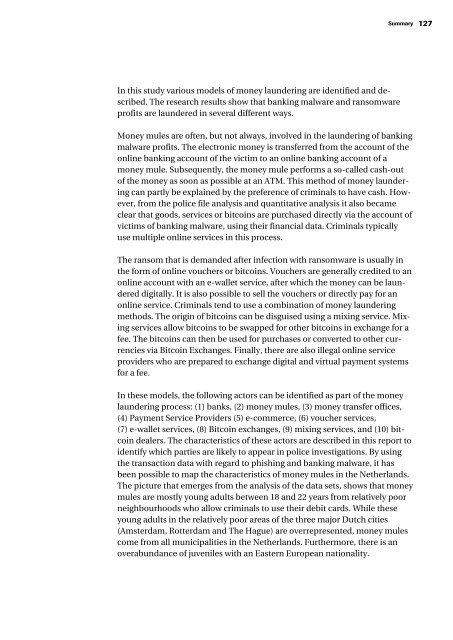Cybercrime en witwassen
O%26B319_Volledige%20tekst_tcm28-228990
O%26B319_Volledige%20tekst_tcm28-228990
Create successful ePaper yourself
Turn your PDF publications into a flip-book with our unique Google optimized e-Paper software.
Summary 127<br />
In this study various models of money laundering are id<strong>en</strong>tified and described.<br />
The research results show that banking malware and ransomware<br />
profits are laundered in several differ<strong>en</strong>t ways.<br />
Money mules are oft<strong>en</strong>, but not always, involved in the laundering of banking<br />
malware profits. The electronic money is transferred from the account of the<br />
online banking account of the victim to an online banking account of a<br />
money mule. Subsequ<strong>en</strong>tly, the money mule performs a so-called cash-out<br />
of the money as soon as possible at an ATM. This method of money laundering<br />
can partly be explained by the prefer<strong>en</strong>ce of criminals to have cash. However,<br />
from the police file analysis and quantitative analysis it also became<br />
clear that goods, services or bitcoins are purchased directly via the account of<br />
victims of banking malware, using their financial data. Criminals typically<br />
use multiple online services in this process.<br />
The ransom that is demanded after infection with ransomware is usually in<br />
the form of online vouchers or bitcoins. Vouchers are g<strong>en</strong>erally credited to an<br />
online account with an e-wallet service, after which the money can be laundered<br />
digitally. It is also possible to sell the vouchers or directly pay for an<br />
online service. Criminals t<strong>en</strong>d to use a combination of money laundering<br />
methods. The origin of bitcoins can be disguised using a mixing service. Mixing<br />
services allow bitcoins to be swapped for other bitcoins in exchange for a<br />
fee. The bitcoins can th<strong>en</strong> be used for purchases or converted to other curr<strong>en</strong>cies<br />
via Bitcoin Exchanges. Finally, there are also illegal online service<br />
providers who are prepared to exchange digital and virtual paym<strong>en</strong>t systems<br />
for a fee.<br />
In these models, the following actors can be id<strong>en</strong>tified as part of the money<br />
laundering process: (1) banks, (2) money mules, (3) money transfer offices,<br />
(4) Paym<strong>en</strong>t Service Providers (5) e-commerce, (6) voucher services,<br />
(7) e-wallet services, (8) Bitcoin exchanges, (9) mixing services, and (10) bitcoin<br />
dealers. The characteristics of these actors are described in this report to<br />
id<strong>en</strong>tify which parties are likely to appear in police investigations. By using<br />
the transaction data with regard to phishing and banking malware, it has<br />
be<strong>en</strong> possible to map the characteristics of money mules in the Netherlands.<br />
The picture that emerges from the analysis of the data sets, shows that money<br />
mules are mostly young adults betwe<strong>en</strong> 18 and 22 years from relatively poor<br />
neighbourhoods who allow criminals to use their debit cards. While these<br />
young adults in the relatively poor areas of the three major Dutch cities<br />
(Amsterdam, Rotterdam and The Hague) are overrepres<strong>en</strong>ted, money mules<br />
come from all municipalities in the Netherlands. Furthermore, there is an<br />
overabundance of juv<strong>en</strong>iles with an Eastern European nationality.


